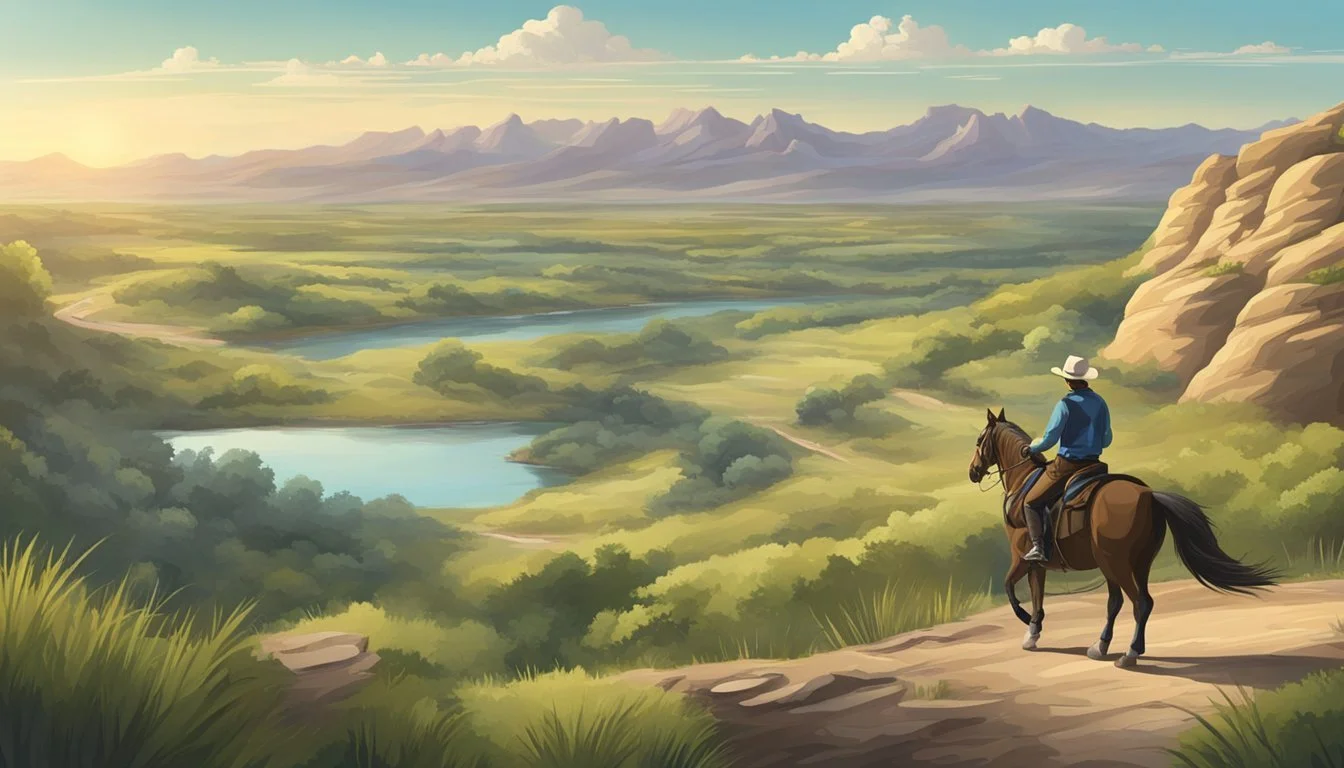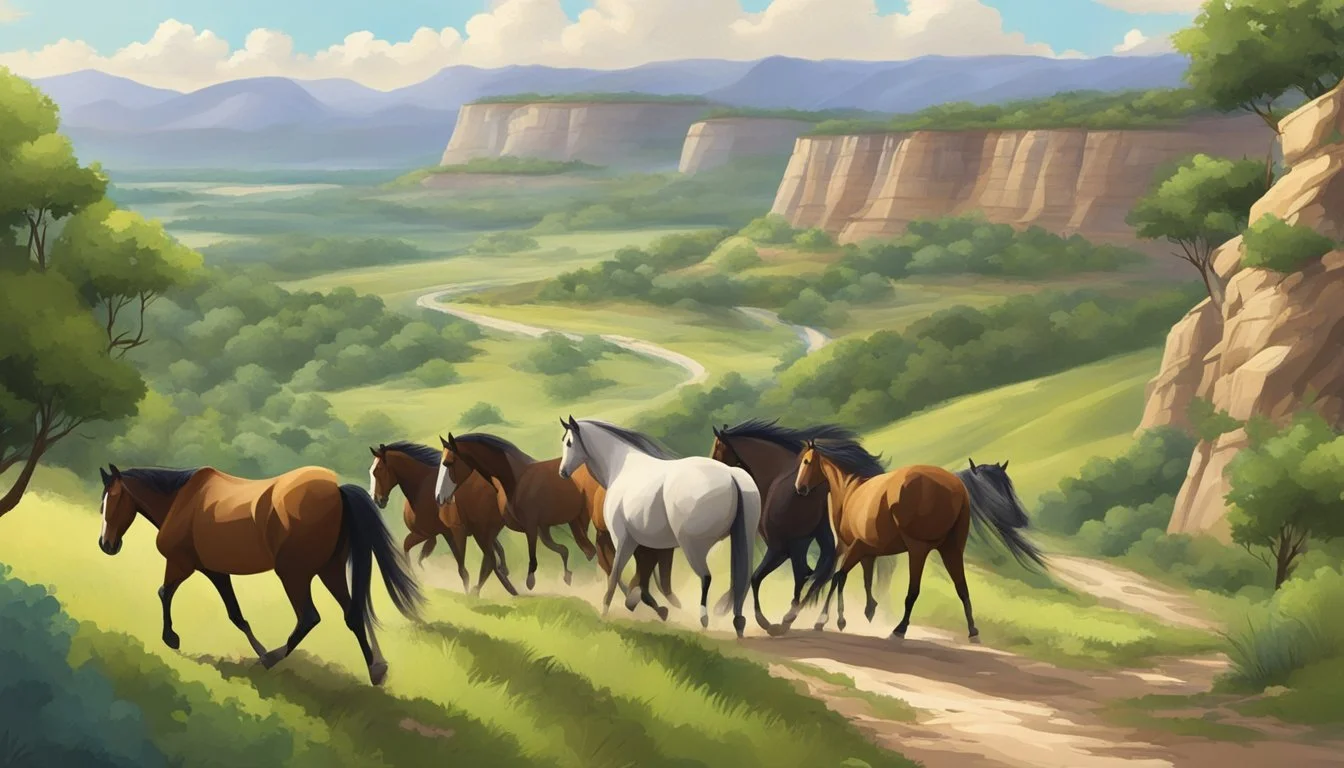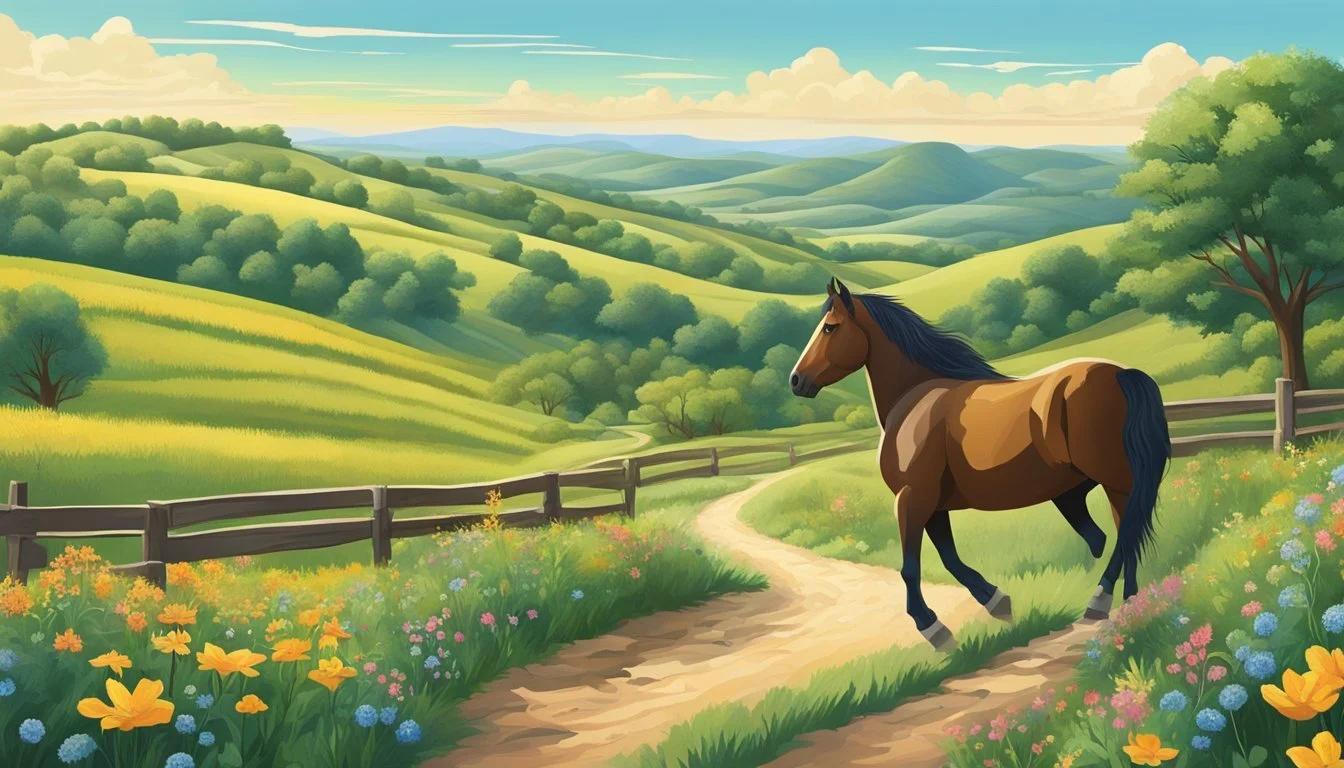The Best Trails for Horseback Riding in Texas
Your Ultimate Guide
Texas offers an exceptional variety of landscapes that make it an ideal destination for horseback riding enthusiasts. The state's expansive parks and historic trails provide riders with an opportunity to explore the rugged beauty of the Lone Star State from the unique vantage point of the saddle. From the sandy shores of the Gulf Coast to the breathtaking canyons of the Panhandle, the trails in Texas have something to cater to every rider's preference.
Horseback riding trails in Texas often wind through scenic terrains, including quiet forests, serene rivers, and majestic mountains. Places such as the Big Bend Ranch State Park in Terlingua showcase the diverse natural beauty of the region and offer a look into the state's rich equestrian history. Trails like the ones found in the Chisholm Trail, with its lush fields and wooded areas, not only provide a great riding experience but also connect riders with the historical significance of the cattle drives that once traversed these paths.
For those looking for a guided ride or hoping to ride on the beach, several parks in Texas also offer horse rentals and special equestrian trails. Such amenities allow both experienced riders and newcomers to enjoy the state's stunning landscapes. The well-maintained trails, combined with the Texas hospitality, ensure that horseback riding remains a favorite activity for visitors and locals alike.
Understanding Horseback Riding in Texas
Texas offers an extensive array of trails and facilities that cater to equestrians of all levels, making it a haven for those passionate about horseback riding. The state's varied landscape ensures a rich diversity of experiences on horseback.
The Popularity of Horse Trails
Texas is renowned for its wide selection of horseback riding trails. Riders can find everything from the serene paths along the Blanco River to the adventurous terrains of Big Bend Ranch State Park. Equestrian trails are meticulously maintained in several state parks, providing safe and enjoyable riding experiences. The popularity of these trails is a testament to the state's commitment to fostering horsemanship and outdoor activities that embrace its natural heritage.
Hill Country: Known for scenic landscapes and rolling hills ideal for all riding levels.
Big Bend Ranch State Park: Offers a more challenging ride with horse rentals available.
Davis Mountains State Park: Features 7 miles of trails in West Texas suitable for riders seeking mountainous paths.
Equestrian Camps and Facilities
Texas not only boasts a variety of trails but also has an abundance of equestrian camps and facilities. These entities provide riders with the necessary amenities, from guided tours for novices to accommodations for those on multi-day riding excursions. Horse rental services are widely available, allowing those without their own horses to enjoy the thrill of horseback riding.
Equestrian Camps: Offer guided rides, lodging, and educational programs about horsemanship.
Facilities: Equipped with trails, stables, and often times arenas; some offer horse rentals to guests.
The equestrian community in Texas supports both the pursuit of recreational riding and the development of rider skills, making it an integral part of the state's outdoor recreational life.
Top Trails for Horseback Riding by Region
Texas offers a remarkable variety of terrains for equestrians, from the sundrenched deserts to lush forests. Each region boasts its top trails that promise an unforgettable ride.
Panhandle Plains
In the Panhandle Plains, Palo Duro Canyon State Park hosts a striking landscape dubbed the Grand Canyon of Texas. The park offers over 30 miles of equestrian trails through the dramatic red rock canyons. Nearby, Caprock Canyons State Park provides a different backdrop with trails that wind past the natural beauty of the red sandstone formations and prairie lands.
Hill Country Highlights
Central Texas's Hill Country features Hill Country State Natural Area, where riders can explore over 40 miles of rugged trails amidst the rolling hills and crystal-clear streams. Equally stunning, Pedernales Falls State Park beckons with trails that traverse around the Pedernales River, offering a mix of tranquil river scenes and challenging rocky paths.
Prairies and Lakes
The Prairies and Lakes region is home to Ray Roberts Lake State Park, which encircles the shimmering lake and boasts a network of multi-use trails suited for horseback riding. Moreover, equestrians can hit the Lake Mineral Wells State Trailway stretching 20 miles through the countryside, connecting Weatherford to Mineral Wells.
South Texas Plains
The South Texas Plains offer the unique brushland landscape. At the heart of this region, riders can explore Brazos Bend State Park, which has trails that lead through the scenic areas of live oaks, meandering creeks, and the chance to observe diverse wildlife.
Piney Woods
Equestrians in search of green canopy can head to East Texas's Piney Woods, where the Lost Creek Reservoir State Trailway provides a verdant corridor of oak and pine forests alongside the serene waterway.
Big Bend Region
The rugged beauty of the Chihuahuan Desert in the Big Bend Region is showcased at Big Bend Ranch State Park, offering more than 70 miles of multi-use trails that highlight the remote desert terrain. Nearby, Davis Mountains State Park presents high-altitude trails with views spanning miles of West Texas's mountainous landscapes.
Selecting Trails Suitable for Your Skill Level
When embarking on horseback riding in Texas, riders must select trails that align with their abilities. Texas offers a diverse range of trails that cater to different skill levels, ensuring riders have a safe and rewarding experience.
Trails for Beginners
For those new to horseback riding, Texas state parks often provide trails with gentle terrains and controlled environments. An example of a beginner-friendly trail is South Llano River State Park, which offers easy trails allowing beginners to focus on mastering the basics of riding without the complication of challenging paths. Beginners should look for trails labeled as "easy" or "beginner-friendly" and consider guided tours, where rangers or experienced instructors can provide additional safety and support.
Challenging Trails for Experienced Riders
Experienced riders in search of a challenge can find numerous trails throughout Texas that offer varying degrees of difficulty. Big Bend Ranch State Park stands out with its scenic routes that include rocky terrain and steep elevation changes, testing both the rider's skill and the horse's endurance. Trails may be designated as "intermediate" or "advanced," indicating more challenging conditions. Experienced riders should ensure they’re familiar with specific trail conditions before the ride, as some may require advanced navigation skills or present potential hazards such as wildlife, sudden drops, or water crossings.
Must-Visit State Parks with Horseback Trails
Texas boasts a variety of state parks featuring trails that cater to horseback riding enthusiasts. These parks offer unique landscapes, from riverine valleys to desert expanses, providing an extensive range of equestrian adventures.
Guadalupe River State Park
Guadalupe River State Park provides riders with a scenic backdrop featuring the picturesque Guadalupe River. The park's trails meander through classic Texas Hill Country, giving horseback riders ample opportunities to enjoy the area's flora and fauna.
Copper Breaks State Park
Copper Breaks State Park includes multi-use trails that make their way through the rugged Red River area. Equestrians can explore trails that offer a unique mix of grassland, juniper, and mesquite terrain, intersected by deep canyons and high mesas.
Sea Rim State Park
At Sea Rim State Park, riders can enjoy a distinctive experience with trails that skirt coastal marshes and sandy shores. The park's equestrian paths allow for serene rides with views of the Gulf of Mexico and opportunities to observe coastal wildlife.
Fort Richardson State Park
Fort Richardson State Park, rich in both history and natural beauty, offers trails that pass historical landmarks and appealing landscapes. The park's well-maintained trails are perfect for riders looking to combine a love of history with their riding experience.
Trail Amenities and Accessibility
When exploring the best trails for horseback riding in Texas, riders should consider the availability of amenities and accessibility features such as trailheads, campsites, rest areas, and trail maps. These facilities enhance the overall experience by providing convenience and essential information.
Parking and Trailheads
Many horseback riding trails in Texas offer designated parking areas, ensuring trail users have a convenient starting point for their adventure. For example, Franklin Mountains State Park provides accessible parking near the trailheads, allowing riders to easily unload their horses and gear. The presence of clear signage at these trailheads offers guidance right from the start.
Campsites and Rest Areas
Trails such as those in Davis Mountains State Park cater to riders seeking longer excursions with availability for primitive camping. Riders can find rest areas along the trails, providing spaces for breaks and overnight stays. It is important for riders to check the specific park regulations and available facilities, as some may offer potable water and basic amenities, while others are more rustic.
Trail Maps and Information
Availability of detailed trail maps can significantly improve the riding experience. TrailLink, for example, provides extensive maps encompassing various Texas trails, including amenities and guidebook descriptions. Riders are encouraged to obtain these maps and any other information prior to their visit to familiarize themselves with the trail specifics, including any multi-use trails where sharing the path with hikers and bikers may be necessary.
Planning Your Horseback Riding Adventure
When embarking on a horseback riding trail in Texas, riders should meticulously prepare by packing essential items, adhering to safety measures, and securing rental arrangements if they do not own horses.
What to Bring
Essential Gear: Riders must equip themselves with a well-fitting helmet, riding boots, and comfortable, durable clothing suitable for varying weather conditions.
Hydration and Nutrition: It's crucial for riders to carry water bottles and snacks to maintain energy levels throughout the ride.
Safety and Guidelines
Rider Skill Level: Matching the trail to the rider's experience level is key. Beginners should opt for less challenging trails, while experienced riders may seek more advanced terrain.
Equine Health: If renting horses or bringing their own, riders must ensure the animals are vaccinated against equine infectious anemia, a health requirement in Texas.
Booking Horse Rentals
Advance Reservations: To guarantee availability, riders should book rental horses well in advance, especially during peak seasons.
Rental Options: Companies often provide an array of rental options, from hour-long rides to extended trail experiences. It's advisable for riders to review and choose based on their skill level and comfort with horses.
Exploring the Natural Beauty on Horseback
Texas offers an extensive range of landscapes ideal for horseback riders looking to absorb the state's natural beauty. This article will guide you through the scenic routes and vistas along with the diverse wildlife and flora found along Texan trails.
Scenic Routes and Vistas
The Lone Star State boasts a vast selection of trails that highlight its diverse geography. Equestrians can experience the Juniper Cliffside Trail at Palo Duro Canyon State Park, where the vistas are unparalleled. Riders will traverse not just through a majestic forest but also encounter a scenic overlook offering panoramic views of the canyon's rich, multi-hued rock formations.
Another noteworthy trail is the Llano River Loop, located within the Hill Country State Natural Area. It features a scenic lake that mirrors the blue Texan skies and vibrant wildflowers during spring. The varied terrain includes serene creek beds and mild ascents leading to stunning views that riders can treasure.
Wildlife and Flora
Texas’ trails provide more than just beautiful views; they are a haven for wildlife and botanical enthusiasts. The Sam Houston National Forest Multi-Use Trail is a prime example, where equestrians can observe local fauna in their natural habitat while surrounded by towering pines and a bevy of blooming flora.
In Big Bend Ranch State Park, the Closed Canyon Trail allows riders to wind through rugged landscape where they can spot a spectrum of desert wildlife, from roadrunners to jackrabbits, nestled among the cacti and brush. The presence of vibrant wildflowers adds a splash of color to the dusty trails, enhancing the overall riding experience.
Additional Resources and Services
When planning a horseback riding adventure in Texas, it's beneficial to consider various additional resources and services that can augment the experience. Utilizing professional guides, outfitters, or seeking horseback riding tours and lessons can provide added value through local expertise, enhanced safety, and a more enriching exploration of Texas's trails.
Horseback Riding Tours and Lessons
For those new to horseback riding or looking to improve their skills, maverick horseback riding and old west stables offer structured tours and lessons tailored for various experience levels. Maverick Horseback Riding provides a unique approach, focusing on the relationship between rider and horse, while Old West Stables, located near Palo Duro Canyon, allows riders to learn in one of Texas's most scenic settings. These tours not only serve as an instruction in horsemanship but also as guided explorations of the scenic landscapes.
Professional Guides and Outfitters
For those looking for expertly guided experiences or to rent horses, professional outfits such as Big Bend and Lajitas Stables and Eagle Eye Ranch Carriage Company offer comprehensive services. These outfitters conduct trail rides that showcase Texas's natural beauty, such as the rugged terrain of Big Bend Ranch State Park or the scenic Caprock Canyons State Park Trailway. Beyond horse rentals and guided tours, these companies often provide additional information about the trails, including maps and insights into the local ecology and history.
Reviews and photos from previous visitors are accessible on their respective websites, serving as a testament to their offerings. Here, one can schedule a trail ride, inquire about horse rentals, or book a horseback tour catered to individual or group needs. These considerations ensure that regardless of one's riding ability, the vast Texas landscapes remain accessible and enjoyable.







